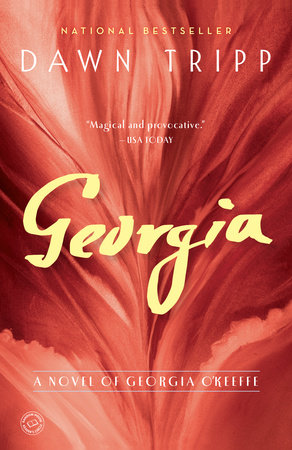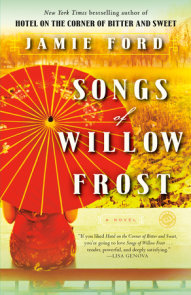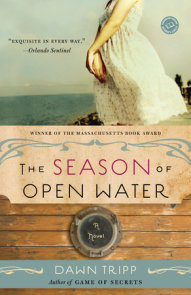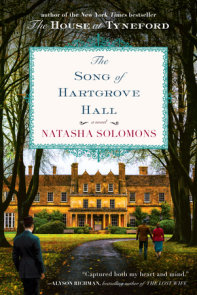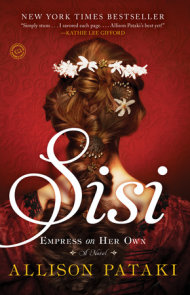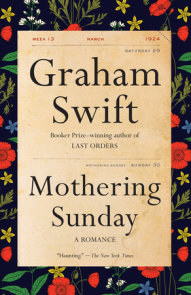READERS GUIDE
A Conversation with Dawn TrippRandom House Reader’s Circle: Why did you choose to write a novel about Georgia O’Keeffe?
Dawn Tripp: It’s a gut impulse, always, that drives me into a story. I came to O’Keeffe through her art, specifically a show of her abstractions at the Whitney Museum in New York. In that show, O’Keeffe’s art was paired with Alfred Stieglitz’s photographs of her—clothed and nude—along with excerpts of their letters, and I was struck by the realization: Here is a woman that most people know of but barely know at all. Growing up, I’d always admired O’Keeffe’s flowers and landscapes, but that day at the Whitney, I fell in love with her abstractions. As early as 1915, Georgia O’Keeffe—not even thirty years old—was creating radically new abstract forms. And I wanted to know: Who was the woman, the artist, who made these shapes? What did she think, feel, want? What was happening in her life? And why have I never seen the full range and power of her abstract work before? Why isn’t she known for this?
There are many stellar, insightful nonfiction works that have been written about O’Keeffe, but I believe that fiction can get at a different kind of truth, an experiential truth that allows us to enter a character’s story and be transformed. Facts and the historical record are always incomplete. Truth is kaleidoscopic, continually changing and evolving according to our perspective. To me, fiction is another means of cutting past the surface to reshape our understanding of what is true, to cast new light on the weight and impact of a life.
In Georgia, I wanted to write a first-person account from O’Keeffe’s point of view, in her voice, as I imagined it. I wanted to get into her head—into the sweeping and intimate world between her and Stieglitz. I wanted to get right up against what she might have felt and thought and questioned, what she loved and feared and ached for, what she fought, remembered, dreamed. I wanted to bring that internal world to life.
RHRC: What intrigued you about the relationship between O’Keeffe and Alfred Stieglitz?
DT: Their love affair was a loaded one: Ambition. Desire. Sex. Love. Fame. Betrayal. A search for artistic freedom. The more I learned, the more I wanted to know. The stormy passion that characterized their marriage was intriguing, but the politics of that relationship, and how those politics impacted the work of both artists, even more so. Here was a young woman—intelligent and independent—with a ferocious artistic talent and a revolutionary vision years ahead of her time, and here was a man—famed art promoter and the father of modern photography—nearly twice her age and at the tail end of his own artistic career. He fell so deeply in love with her, had faith in her greatness, but needed to orchestrate every element of the world around him, blind to the risk of losing what he wanted most.
O’Keeffe was a strong woman who recognized that passion, sexual and otherwise, can be a key inspiration for creative work. That said, she refused to allow her art to be described in the eroticized language first assigned to it—language born out of Stieglitz’s photographs of her and cultivated by the primarily male modernist New York art world of the 1920s. O’Keeffe balked at the feminization of her work. She had no interest in being a great female artist. She wanted her work viewed simply as art. She began to take clear, methodical steps to create a new lens and language to frame her artistic vision.
RHRC: Georgia is a highly researched historical novel. What was that experience like?
DT: Research is always a process of discovery. There is so much you learn about a person, a world, an era. You see the underside of things and it sparks your imagination. That process itself is thrilling. One thing that did strike me—and continues to strike me—is that O’Keeffe has been a powerful force in the consciousness of many women over time—artists, writers, feminists, curators, scholars—who have consistently dedicated themselves to holding her and her life up in a way that has ultimately precipitated a meaningful reassessment of her work and influence on twentieth-century American Art.
Georgia is a novel grounded in the actual events of O’Keeffe’s life during the years she lived with Stieglitz in New York. Those years were a crucible for her. Those were the years when her art was first recognized. Those were the years when she fell in love, craved a child, had her heart broken, became famous, nearly lost what mattered to her most, and resolved never to compromise again. Those were the years when she made unthinkable sacrifices in her life and key innovations in her art. To my sense, those years forged her greatness. Not because of what Stieglitz, or anyone else, did for her, or to her, but for how she met and overcame the challenges and the gender bias that she faced; and for how she went on to shape the direction of her art and career on her own terms.
RHRC: What was your primary goal in writing this novel? Why did you decide to take on the story of a key American figure and explore—through fiction—a part of her life that is less well known?
DT: Vladimir Nabokov once called the art of fiction “a shimmering go-between” and that’s the space I wanted to write into—the space between what happened and what could have. I wanted to craft a story about true events and circumstances to explore how O’Keeffe might have met and experienced those events, and also to reveal how our perception of her—even to this day—has been shadowed by the gendered language assigned to her early work. I believe in O’Keeffe’s strength, her genius, and the creative innovations she made. The abstract art she was creating as early as 1915—and the abstractions she continued to create throughout her lifetime—gave rise to some of the most important artistic movements of the twentieth century. My hope is that Georgia gives readers a glimpse into that. And I hope it brings people to her art.
RHRC: What was the greatest challenge for you writing Georgia?
DT: The voice. It took me over a year to find the voice of this novel. I did research, filled notebooks (I still write my early drafts longhand). I studied her paintings and the evolution of her art over time. I looked at Stieglitz’s portraits of her and portraits made by other photographers taken later in her life. I wrote pieces of scene, fragments of thought and dialogue, but most of those early pages felt like cardboard, and I tore them up. Throughout that first year of work, I’d catch glimpses of what I thought the voice would be, but I couldn’t quite nail it.
I was not at my desk when it hit me. I was outside, down at the river with my two boys. It was a warm afternoon in April. They had their jeans rolled up and were playing in the water. I was lying on the dock in the sun, and the words came: “I no longer love you as I once did, in the dazzling rush of those early days. Time itself was feverish then, our bodies filled with fire. . . .”
I sat up and looked around and the world was different. I started writing the following day.
RHRC: Do you think O’Keeffe would have become the American icon she is today if she had stayed with Stieglitz?
DT: She might have been an iconic figure, but she would have been a different kind of icon if she had not removed herself from New York and the confines of that landscape and that life. That said, O’Keeffe is only just beginning to get her fair share of recognition in the art world. Last summer the Tate Modern in the UK held its first major retrospective of O’Keeffe’s work and stated its goal to: “review O’Keeffe’s work in depth and reassess her place in the canon of twentieth-century art, situating her within artistic circles of her own generation and indicating her influence on artists of subsequent generations.” O’Keeffe has been known as one of the most famous figures of American art, but she has—often and incorrectly—been considered simply a “popular artist.” Nothing could be further from the truth. The range of her work is stunning. Her abstractions are masterful—visceral, glowing, cerebral, strikingly original and precise.
RHRC: This novel took six years to write. What was it like to be engaged so deeply in Georgia O’Keeffe’s life for that length of time?
DT: For me, writing is a kind of soul-excavation that is personal and, at the same time, transcends the personal. O’Keeffe’s fierce spirit, her determination to build a life on her own terms, and the sacrifices she made for the sake of her art, remain the most inspiring aspects of her story.
Growing older, I’ve come to understand that a key part of a creative life—whether you are a working artist or not—is recognizing that every day is a choice. You choose to dedicate more or less time to a given endeavor. You develop ways to balance your work with your personal life. To me, that awareness of everyday choices is exhilarating, and there is also an attendant sadness. Every choice comes with a sacrifice. That’s not a reason not to make it, or to apologize for a choice you’ve made. Choices made at one point in your life may change as the parameters of your life change. I believe in staying open to that. O’Keeffe was a strong, innovative woman who achieved fame and success in an art world dominated by men—male painters, critics, gallery owners. She did not apologize for the choices she made, and she continued to make bold choices, again and again, as she aged. That alone makes her story intensely relevant to women and artists today. It will make her story relevant years from now.
Questions and Topics for Discussion
1. Georgia O’Keeffe is a woman many people know of, but her life as a young woman in New York is a chapter that is less well known. How did your understanding of O’Keeffe and her art change as you were reading Georgia?
2. O’Keeffe was a groundbreaking female artist at a time when the art world was dominated by men. O’Keeffe had to navigate this world – of male artists, male critics and gallery owners – to build a successful career without sacrificing her unique artistic vision and her sense of herself as a woman. Discuss some of the challenges O’Keeffe faces in Georgia. Discuss how those challenges as well as the risks she took – as a woman and as an artist – feel relevant to women today.
3. Think about O’Keeffe’s childhood. Do you feel that the lessons she learned growing up shaped her early relationship with Stieglitz and the choices she would make later? Although O’Keeffe’s mother died from tuberculosis a year before O’Keeffe traveled to New York to see her first show at 291, O’Keeffe is haunted by her mother, and by the choices that her mother made. Why were these choices significant, and what was their impact on O’Keeffe?
4. O’Keeffe’s passion for the landscape is a powerful engine for her art. At one point, early in the novel, O’Keeffe thinks to herself that Stieglitz and his faith in her art are “like that open space, vast like these plains, this night, vast enough it seems sometimes to hold me.” Do you agree with this? In what ways is this perception true when O’Keeffe first meets Stieglitz, and in what ways does it change as she matures? Do you feel her experience is one common to women as they evolve and change in the course of their lives?
5. In the opening chapter of the book, O’Keeffe contends: “This is not a love story. If it were, we would have the same story. But he has his, and I have mine.” What do you think O’Keeffe means when she says this? In what ways is Georgia a love story? How does O’Keeffe’s understanding of the word ‘love’ change in the course of the novel?
6. When their relationship was going through a challenging time, O’Keeffe wrote to Stieglitz from New Mexico:
“There is a bond – that is my feeling for you – it is deeper than anything you can do to me –”
What are your first impressions of this statement? Do these words reflect Georgia’s strength and self-awareness? Her commitment to Stieglitz? Or do they reflect something else? How do these words interface with Georgia’s struggle to balance her own needs with the demands of her relationship? How do these words play out in the course of the story?
7. Discuss O’Keeffe’s breakdown. Why do you think she falls apart?
8. Discuss what it means to O’Keeffe when she feels she is unable to paint, and when she says: “This isn’t just him, and what he’s done to me. It’s what I’ve let him do.” Do you agree? Do you believe that every relationship – no matter how passionate or spiritual – is a kind of transaction?
9. Desire is a powerful force for O’Keeffe – artistic desire; desire for place, connection, and solitude; desire between two people. How does O’Keeffe’s relationship to desire change? What does her exchange with Toomer toward the end of the book say about what she has learned? Discuss the ways in which love and desire overlap and diverge. Which is more vital to O’Keeffe? Which do you believe is more vital in your own life?
10. Georgia’s relationship with Stieglitz was complex and controversial – it was a source of artistic growth for both artists, but it was also restricting. Discuss the dynamics in the relationship. Do they remind you of relationships in your own life – either relationships you have observed or relationships you have experienced? How have those relationships impacted your life? What have you learned from them?
11. Reflect on O’Keeffe’s relationships with other women in the novel. What did those relationships mean to her? How did those relationships differ from her various relationships with men – including Stieglitz, Strand, Steichen, Rosenfeld, and others?
12. In the final sections of the novel, O’Keeffe becomes the legendary artist we know. What sacrifices does she make as a result? Do you feel these were sacrifices she had to make in order to live and work on her own terms? Do you think those choices are unique to her? In what ways do you feel they are common choices that all women face?
13. If you could have one O’Keeffe painting in your home, which one would it be? Before reading this novel, would you have chosen a different O’Keeffe painting? How has your understanding of O’Keeffe and her art changed as a result of reading Georgia?
14. What do you think it means to be an icon? What did it mean to O’Keeffe during the time she was with Stieglitz? How did her identity and portrayal as an American icon change over the course of her life?
15. O’Keeffe is known for being fiercely independent, and she is often seen as a “foremother of the feminist movement.” O’Keeffe herself, however, publicly eschewed any “–ism,” including feminism. Consider the gender dynamics in Georgia. Do you feel it was the politics of O’Keeffe’s relationship with Stieglitz, her upbringing and the hardship of her young adult life, or her unique creative vision that shaped her resolute unwillingness to be associated with any movement, artistic or otherwise? Why do you feel that was so important to her? Discuss.









